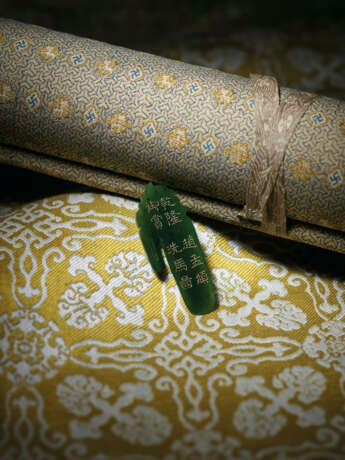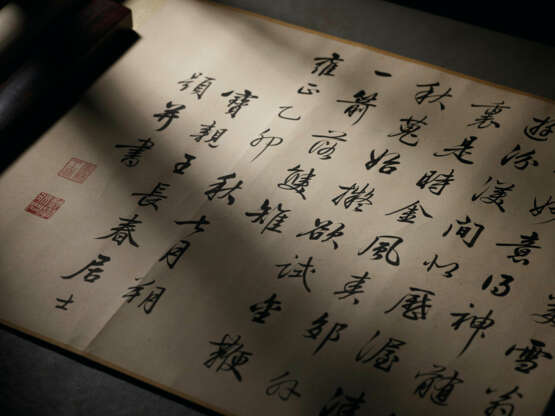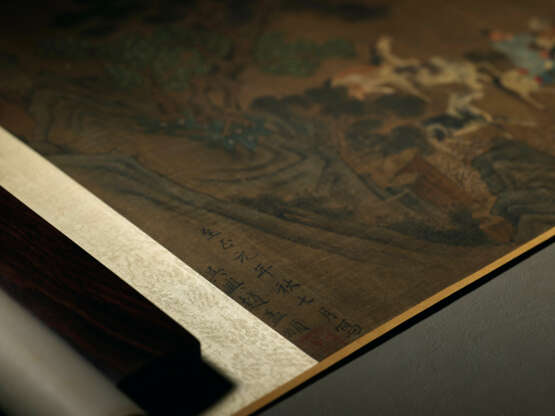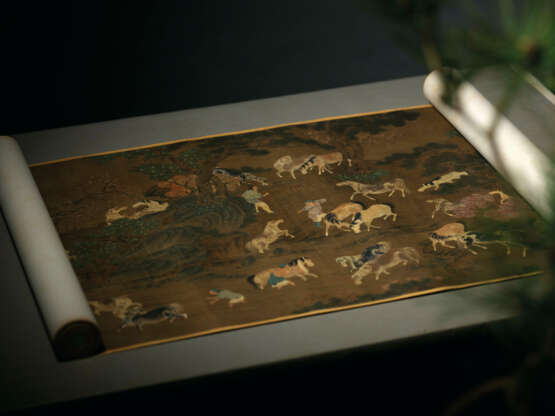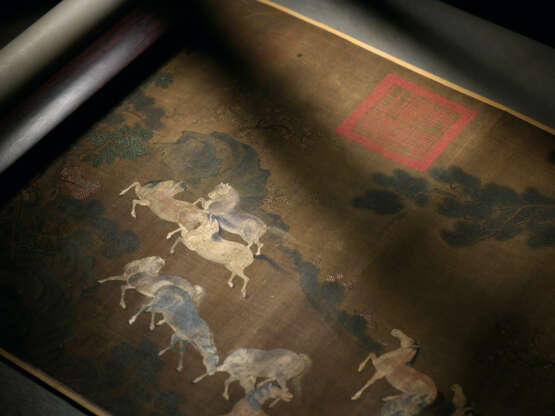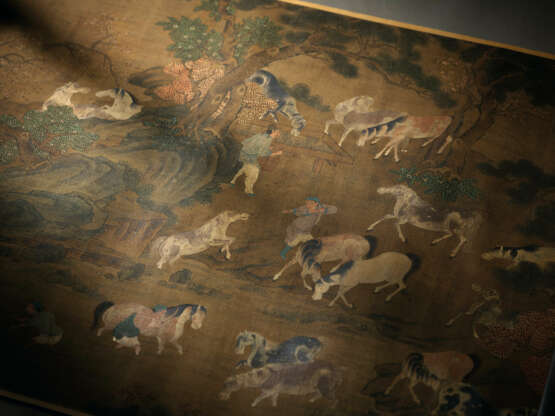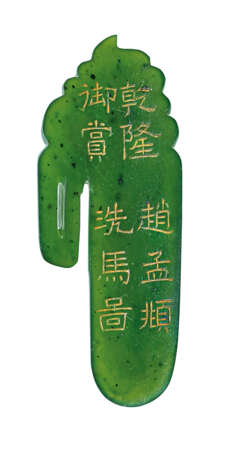ID 770787
Lot 868 | ZHAO MENGFU (1254-1322) AS CATALOGUED IN SHIQU BAOJI
Valeur estimée
HKD 16 000 000 – 24 000 000
Washing Horses
Handscroll, ink and colour on silk
37.9 x 309.4 cm. (14 7⁄8 x 121 3⁄4 in.)
Inscribed and signed, with one seal of the artist
Dated autumn, seventh month, first year of the Zhizheng period (1341)
Frontispiece inscribed a poem and signed by Emperor Qianlong (1711-1799), with three seals
Dated autumn, seventh month, first day, yimao year (1735)
Four collectors’ seals of Emperor Qianlong and one of Emperor Jiaqing (1760-1820)
TRANSLATION OF THE POEM BY EMPEROR QIANLONG:
The expansive countryside sprawls out in all directions; a clear river shimmers.
Grotesque rocks protrude from the blue waves; red and purple peep through the oak trees.
Government grooms drive horses from the imperial stables; washing them in a bright stream.
A flushed-face groom slouches on his saddle; a young servant boy is given free rein.
The horses number in ten thousand, all of superb pedigree.
Fine horses have different temperament, as they appreciate a beautiful landscape.
They gallop like flying dragons; they relax like resting wild swans. Racing each other, clouds of dirt are kicked up from the ground.
A stallion is pursuing a mare; a dam is nursing her foal. And there are those by themselves, with tall and full manes.
These noble steeds can gallop long distance; they can break through a fortified army of ten thousand.
I have viewed Li Gonglin, who was always exceptionally skilled in painting horses beautifully.
Zhao Mengfu depicted the complete landscape [instead]; his whimsical approach has captured the essence of the horses.
Wandering on the river Fei and lake Mei; as if we are in the legendary land of celestial horses.
As the autumn wind whistles, country hunting begins.
[I am] eager to try the golden whip, downing two pheasants with one arrow.
Provenance
Lot 512, 15 March 2017, Important Chinese Art From The Fujita Museum, Christie’s New York.
Literature
Emperor Gaozong, Shiqu Baoji Chubian, 1745, Facsimile reprint, National Palace Museum, Taipei, 1971, pp.1048-1049. (described as "secondary quality")
Full Collection of Hall of Benevolence, Chapter 22, in Siku Quanshu - Ji (The Complete Books of the Four Repositories - Collections), The Commercial Press Ltd., Taipei, 1986. (Poem by Qianlong)
Special notice
The period, dating and the name of artist of this lot in this catalogue are based solely on their corresponding documentation in Shiqu Baoji. Therefore, Christie’s does notwarrant the period, dating and artist of this lot. For the avoidance of doubt, Christie’s only warrants, for the period stated in paragraph E(2)(k) of the Conditions of Sale, that this lot was documented in Shiqu Baoji as being part of the imperial collection. This Special Legal Notice prevails over the Conditions of Sale in case of inconsistency. The English version of this catalogue is the only binding version, any Chinese translation provided is for reference only.
Post lot text
Never be Apart: Emperor Qianlong and Washing HorsesIn the autumn of 1735, the 24-year-old crown prince Hongli inscribed a pentatonic poem on the frontispiece of Zhao Mengfu’s (1254-1322) Washing Horses handscroll. Untrammeled and sinuous, Hongli’s aristocratically elegant calligraphy seemingly leaps from the paper.Hongli was an avid collector during his crown prince years. According to the imperial catalogue Shiqu Baoji, 38 works he collected from this period are included in its compilation. Many of the extant masterpieces, such as Tang Yin’s Long Days in Tranquil Mountains and Tang Dai’s Playing Zither under Pine Trees, are currently preserved at the National Palace Museum in Taipei. It is extremely rare that Washing Horses still remain in private hands.A few months after Hongli’s inscription, he ascended the throne and become Emperor Qianlong (r. 1735–1796). Consequently, Washing Horses was transferred from his crown prince mansion to the imperial study. In 1744, Emperor Qianlong ordered the compilation and editing of Shiqu Baoji, in order to have a comprehensive record of the imperial collection of paintings and calligraphy. Details of Washing Horses, including the text of the frontispiece and the various seals pressed on it are presented in Chapter 34.The information recorded in Shiqu Baoji is corroborated by examining Washing Horses. The handscroll also bears three seals from Hongli when he was the crown prince, three imperial seals from Emperor Qianlong and one from his son, Emperor Jiaqing (r. 1796– 1820). Evidently Emperor Qianlong acquired this work in his youth and continued to treasure it as he brought it with him to the imperial study.One of the rarest aspect of Washing Horses is the fact that it has retained the original mounting. Made in the imperial atelier, the two well-preserved silk and brocade wraps are incredibly soft. The delicately carved jade clasp is embodied on the reverse ‘Appreciated by Emperor Qianlong, Zhao Mengfu’s Washing Horses’ in gold. The other fabric and paper pieces in the mounting are equally refined, with thoughtful design to emphasize the contrast of colors and patterns.After the relocation from the crown prince’s mansion to the emperor’s study in the Forbidden Palace, the Washing Horses handscroll and its accessories have virtually retained its original appearance. In April of 1915, it was sold to Yamanaka & Co. and entered the Fujita Art Museum’s collection in Japan. A century later, it was sold as part of a selection of works from the museum at Christie’s New York in March 2017. This record-breaking auction attracted numerous collectors around the world, leading to energetic biddings. This event certainly has contributed to the increased attention showered on Chinese classical paintings and calligraphy since then. After more than a century as a peripatetic masterpiece, Washing Horses now has the potential to return to its homeland.The Regal Treasures –A glimpse of works from the Qing Imperial CollectionSince the establishment of the Qing dynasty, the Manchu rulers decided early on to Sinicize in order to facilitate their minority rule over a large Han Chinese population. From Emperor Kangxi onwards, all princes were required to study both Manchu and Chinese so as to strengthen the sovereignty.This spring we have three outstanding treasures from the Qing court. First is Almanac of the Second Year of the Yongzheng Period (Lot 869). Handwritten in ink and vermilion by the Bureau of Astronomy for the Emperor Yongzheng in 1724, this pocket-size calendar was meant to be a personal belonging of the emperor. The second treasure is Zhao Mengfu’s Washing Horses as catalogued in Shiqu Baoji (Lot 868). A few months before his ascension to the throne, the crown prince Hongli inscribed a long five-character poem on the frontispiece of his beloved handscroll. Once he became emperor Qianlong, he ordered the compilation of Shiqu Baoji where it was officially documented in the Qing imperial collection. The various imperial seals impressed on it together with its original imperial mounting, ‘Eight Treasures’ cord and cord clasp further add value to this masterpiece. Lastly is Grapes by Empress Dowager Cixi (Lot 870), an elegant composition in beautiful colours complemented with colophons by four officials. Rare and seldomly available, these regal treasures are always sought after by discerning collectors.
| Style artistique: | Сlassicisme |
|---|
| Style artistique: | Сlassicisme |
|---|
| Adresse de l'enchère |
CHRISTIE'S 18 Chater Road Central Hong Kong Hong Kong | ||||||||||||||
|---|---|---|---|---|---|---|---|---|---|---|---|---|---|---|---|
| Aperçu |
| ||||||||||||||
| Téléphone | +85227601766 | ||||||||||||||
| Fax | +852 2760 1767 | ||||||||||||||
| Conditions d'utilisation | Conditions d'utilisation | ||||||||||||||
| Heures d'ouverture | Heures d'ouverture
|




